Shifting Importance of Abiotic versus Biotic Filtering from Intact Mature Forests to Post-Clearcut Secondary Forests
Abstract
:1. Introduction
- Do community-level trait means, trait ranges, and trait–trait covariation reflective of external-environmental filtering vary among intact mature forest versus post-clearcut secondary forests?
- Do community-level inter and intraspecific trait variation reflective of biotic filtering vary among intact mature forest versus post-clearcut secondary forests?
- Do species-level alpha- and beta-trait values, as well as niche breaths, vary among intact mature forests versus post-clearcut secondary forests?
2. Materials and Methods
2.1. Study System and Natural History
2.2. Sampling Design
2.3. Vegetation and Environmental Data
2.4. Functional Traits
2.5. Quantifying Plot- and Species-Level Trait Mean, Range, Variation, and Trait–Trait Covariation
2.6. Statistical Analysis
3. Results
3.1. Community-Level Trait Mean, Range, and Trait–Trait Covariation Vary among Intact Mature Forest versus Post-Clearcut Secondary Forests
3.2. Community-Level Inter and Intraspecific Trait Variations Vary among Intact Mature Forest versus Post-Clearcut Secondary Forests
3.3. Species-Level Trait Mean, Alpha-Trait and Beta-Trait, and Niche-Breadth Vary among Intact Mature Forests versus Post-Clearcut Secondary Forests
4. Discussion
4.1. Shifting Ecological Strategies along a Disturbance Gradient
4.2. Shifting Importance of Assembly Processes along a Disturbance Gradient
4.3. Implications for Management
Supplementary Materials
Author Contributions
Funding
Data Availability Statement
Acknowledgments
Conflicts of Interest
References
- Cornwell, W.K.; Ackerly, D.D. Community assembly and shifts in plant trait distributions across an environmental gradient in coastal California. Ecol. Monogr. 2009, 79, 109–126. [Google Scholar] [CrossRef] [Green Version]
- Spasojevic, M.J.; Suding, K.N. Inferring community assembly mechanisms from functional diversity patterns: The importance of multiple assembly processes. J. Ecol. 2012, 100, 652–661. [Google Scholar] [CrossRef]
- Kraft, N.J.B.; Adler, P.B.; Godoy, O.; James, E.C.; Fuller, S.; Levine, J.M. Community assembly, coexistence and the environmental filtering metaphor. Funct. Ecol. 2015, 29, 592–599. [Google Scholar] [CrossRef]
- Ottaviani, G.; Tsakalos, J.L.; Keppel, G.; Mucina, L. Quantifying the effects of ecological constraints on trait expression using novel trait-gradient analysis parameters. Ecol. Evol. 2018, 8, 435–440. [Google Scholar] [CrossRef] [PubMed] [Green Version]
- Cadotte, M.W.; Tucker, C.M. Should Environmental Filtering be Abandoned? Trends Ecol. Evol. 2017, 32, 429–437. [Google Scholar] [CrossRef]
- Violle, C.; Enquist, B.J.; Mcgill, B.J.; Jiang, L.; Albert, C.H.; Hulshof, C.; Jung, V.; Messier, J. The return of the variance: Intraspecific variability in community ecology. Trends Ecol. Evol. 2012, 27, 244–252. [Google Scholar] [CrossRef]
- Han, X.; Huang, J.; Yao, J.; Xu, Y.; Ding, Y.; Zang, R. Effects of logging on the ecological strategy spectrum of a tropical montane rain forest. Ecol. Indic. 2021, 128, 107812. [Google Scholar] [CrossRef]
- Chazdon, R.L. Second Growth: The Promise of Tropical Forest Regeneration in an Age of Deforestation; University of Chicago Press: Chicago, IL, USA, 2014. [Google Scholar]
- Ding, Y.; Zang, R.; Lu, X.; Huang, J. The impacts of selective logging and clear-cutting on woody plant diversity after 40 years of natural recovery in a tropical montane rain forest, south China. Sci. Total Environ. 2017, 579, 1683–1691. [Google Scholar] [CrossRef]
- Chazdon, R.L. Tropical forest recovery: Legacies of human impact and natural disturbances. Perspect. Plant Ecol. Evol. Syst. 2003, 6, 51–71. [Google Scholar] [CrossRef] [Green Version]
- Yan, E.-R.; Wang, X.-H.; Huang, J.-J. Shifts in plant nutrient use strategies under secondary forest succession. Plant Soil 2006, 289, 187–197. [Google Scholar] [CrossRef]
- Wang, X.-H.; Kent, M.; Fang, X.-F. Evergreen broad-leaved forest in Eastern China: Its ecology and conservation and the importance of resprouting in forest restoration. For. Ecol. Manag. 2007, 245, 76–87. [Google Scholar] [CrossRef]
- Guariguata, M.R.; Ostertag, R. Neotropical secondary forest succession: Changes in structural and functional characteristics. For. Ecol. Manag. 2001, 148, 185–206. [Google Scholar] [CrossRef]
- Biswas, S.R.; Mallik, A.U. Disturbance effects on species diversity and functional diversity in riparian and upland plant communities. Ecology 2010, 91, 28–35. [Google Scholar] [CrossRef] [PubMed]
- Clements, F.E. Plant Succession: An Analysis of the Development of Vegetation; Carnegie Institution of Washington: Washington, DC, USA, 1916; Volume 242. [Google Scholar]
- Odum, E.P. The Strategy of Ecosystem Development. Science 1969, 164, 262–270. [Google Scholar] [CrossRef] [PubMed] [Green Version]
- Ackerly, D.D.; Cornwell, W.K. A trait-based approach to community assembly: Partitioning of species trait values into within- and among-community components. Ecol. Lett. 2007, 10, 135–145. [Google Scholar] [CrossRef] [PubMed]
- Weiher, E.; Keddy, P.A. Assembly Rules, Null Models, and Trait Dispersion: New Questions from Old Patterns. Oikos 1995, 74, 159–164. [Google Scholar] [CrossRef] [Green Version]
- Cornwell, W.K.; Schwilk, D.W.; Ackerly, D.D. A trait-based test for habitat filtering: Convex hull volume. Ecology 2006, 87, 1465–1471. [Google Scholar] [CrossRef]
- Dwyer, J.M.; Laughlin, D.C. Constraints on trait combinations explain climatic drivers of biodiversity: The importance of trait covariance in community assembly. Ecol. Lett. 2017, 20, 872–882. [Google Scholar] [CrossRef]
- He, D.; Biswas, S.R.; Xu, M.S.; Yang, T.H.; You, W.H.; Yan, E.R. The importance of intraspecific trait variability in promoting functional niche dimensionality. Ecography 2021, 44, 380–390. [Google Scholar] [CrossRef]
- MacArthur, R.; Levins, R. The limiting similarity, convergence, and divergence of coexisting species. Am. Nat. 1967, 101, 377–385. [Google Scholar] [CrossRef]
- Spasojevic, M.J.; Turner, B.L.; Myers, J.A. When does intraspecific trait variation contribute to functional beta-diversity? J. Ecol. 2016, 104, 487–496. [Google Scholar] [CrossRef] [Green Version]
- Gross, N.; Kunstler, G.; Liancourt, P.; De Bello, F.; Suding, K.N.; Lavorel, S. Linking individual response to biotic interactions with community structure: A trait-based framework. Funct. Ecol. 2009, 23, 1167–1178. [Google Scholar] [CrossRef]
- Westerband, A.C.; Funk, J.L.; Barton, K.E. Intraspecific trait variation in plants: A renewed focus on its role in ecological processes. Ann. Bot. 2021, 127, 397–410. [Google Scholar] [CrossRef] [PubMed]
- Yao, L.; Ding, Y.; Yao, L.; Ai, X.; Zang, R. Trait Gradient Analysis for Evergreen and Deciduous Species in a Subtropical Forest. Forests 2020, 11, 364. [Google Scholar] [CrossRef] [Green Version]
- Xiang, J. Effects of Forest Conversion on Spatial Aotocorrelation in Plant Species and Functional Diversity in Tiantong National Forest Park. Master’s Thesis, East China Normal University, Shanghai, China, 2021. [Google Scholar]
- Lu, H.P.; Wagner, H.H.; Chen, X.Y. A contribution diversity approach to evaluate species diversity. Basic Appl. Ecol. 2007, 8, 1–12. [Google Scholar] [CrossRef]
- Da, L.; Yang, Y.; Song, Y. Poplation structure and regneration types of dominant speies in evergreen broadleaved forest in tiantong national forest park, Zhejiang province, eastern china. Acta Phytoecol. Sin. 2004, 28, 376–384. [Google Scholar]
- Li, H. Scale-Dependent Effects of Forest Conversion on Species and Functional Diversity in Zhejiang Tiantong National Forest Park. Master’s Thesis, East China Normal University, Shanghai, China, 2021. [Google Scholar]
- Yang, Q.; Ma, Z.; Xie, Y.; Zhang, Z.; Wang, Z.; Liu, H.; Li, P.; Zhang, N.; Wang, D.; Yang, H.; et al. Community structure and species composition of an evergreen broad-leaved forest in Tiantong’s 20 ha dynamic plot, Zhejiang Province, eastern China. Biodivers. Sci. 2011, 19, 215–223. [Google Scholar]
- Zhejiang Provincial Bureau of Statistics. Zhejiang Statistical Yearbook; Zhejiang Provincial Bureau of Statistics: Hangzhou, China, 2020.
- Ding, S.; Song, Y. Study on the synecological characteristics of the early successional stage of an evergreen broadleaved forest on Tiantong National Forest Park, Zhejiang province. Acta Phytoecol. Sin. 1999, 23, 97–107. [Google Scholar]
- Adler, P.B.; Salguero-Gomez, R.; Compagnoni, A.; Hsu, J.S.; Ray-Mukherjee, J.; Mbeau-Ache, C.; Franco, M. Functional traits explain variation in plant life history strategies. Proc. Natl. Acad. Sci. USA 2014, 111, 740–745. [Google Scholar] [CrossRef] [Green Version]
- Reich, P.B.; Walters, M.B.; Ellsworth, D.S. From tropics to tundra: Global convergence in plant functioning. Proc. Natl. Acad. Sci. USA 1997, 94, 13730–13734. [Google Scholar] [CrossRef] [Green Version]
- Garnier, E.; Cortez, J.; Billes, G.; Navas, M.L.; Roumet, C.; Debussche, M.; Laurent, G.; Blanchard, A.; Aubry, D.; Bellmann, A.; et al. Plant functional markers capture ecosystem properties during secondary succession. Ecology 2004, 85, 2630–2637. [Google Scholar] [CrossRef]
- Gratani, L.; Varone, L.; Crescente, M.F.; Catoni, R.; Ricotta, C.; Puglielli, G. Leaf thickness and density drive the responsiveness of photosynthesis to air temperature in Mediterranean species according to their leaf habitus. J. Arid. Environ. 2018, 150, 9–14. [Google Scholar] [CrossRef]
- Bakker, M.A.; Carreno-Rocabado, G.; Poorter, L. Leaf economics traits predict litter decomposition of tropical plants and differ among land use types. Funct. Ecol. 2011, 25, 473–483. [Google Scholar] [CrossRef]
- Carreno-Rocabado, G.; Pena-Claros, M.; Bongers, F.; Diaz, S.; Quetier, F.; Chuvina, J.; Poorter, L. Land-use intensification effects on functional properties in tropical plant communities. Ecol. Appl. 2016, 26, 174–189. [Google Scholar] [CrossRef] [PubMed] [Green Version]
- Pauli, D.; White, J.W.; Andrade-Sanchez, P.; Conley, M.M.; Heun, J.; Thorp, K.R.; French, A.N.; Hunsaker, D.J.; Carmo-Silva, E.; Wang, G.; et al. Investigation of the Influence of Leaf Thickness on Canopy Reflectance and Physiological Traits in Upland and Pima Cotton Populations. Front. Plant Sci. 2017, 8, 1405. [Google Scholar] [CrossRef] [PubMed] [Green Version]
- Gillison, A.N. Plant functional indicators of vegetation response to climate change, past present and future: I. Trends, emerging hypotheses and plant functional modality. Flora 2019, 254, 12–30. [Google Scholar] [CrossRef]
- Hunt, E.R.; Weber, J.A.; Gates, D.M. Effects of Nitrate Application on Amaranthus powellii Wats. III. Optimal Allocation of Leaf Nitrogen for Photosynthesis and Stomatal Conductance. Plant Physiol. 1985, 79, 619–624. [Google Scholar] [CrossRef]
- Reich, P.B.; Oleksyn, J. Global patterns of plant leaf N and P in relation to temperature and latitude. Proc. Natl. Acad. Sci. USA 2004, 101, 11001–11006. [Google Scholar] [CrossRef] [Green Version]
- Zhang, J.; He, N.; Liu, C.; Xu, L.; Chen, Z.; Li, Y.; Wang, R.; Yu, G.; Sun, W.; Xiao, C.; et al. Variation and evolution of C:N ratio among different organs enable plants to adapt to N-limited environments. Glob. Chang. Biol. 2020, 26, 2534–2543. [Google Scholar] [CrossRef]
- Güsewell, S. N:P ratios in terrestrial plants: Variation and functional significance. New Phytol. 2004, 164, 243–266. [Google Scholar] [CrossRef]
- Chen, X.; Chen, H.Y.H. Plant mixture balances terrestrial ecosystem C:N:P stoichiometry. Nat. Commun. 2021, 12, 4562. [Google Scholar] [CrossRef] [PubMed]
- Cornelissen, J.H.C.; Lavorel, S.; Garnier, E.; Díaz, S.; Buchmann, N.; Gurvich, D.E.; Reich, P.B.; Steege, H.T.; Morgan, H.D.; van der Heijden, M.G.A.; et al. A handbook of protocols for standardised and easy measurement of plant functional traits worldwide. Aust. J. Bot. 2003, 51, 335–380. [Google Scholar] [CrossRef] [Green Version]
- Pérez-Harguindeguy, N.; Díaz, S.; Garnier, E.; Lavorel, S.; Poorter, H.; Jaureguiberry, P.; Bret-Harte, M.S.; Cornwell, W.K.; Craine, J.M.; Gurvich, D.E.; et al. New handbook for standardised measurement of plant functional traits worldwide. Aust. J. Bot. 2013, 61, 167–234. [Google Scholar] [CrossRef]
- Licon, C. Proximate and Other Chemical Analyses. In Encyclopedia of Dairy Sciences, 3rd ed.; McSweeney, P.L.H., McNamara, J.P., Eds.; Academic Press: Oxford, MA, USA, 2022; pp. 521–529. [Google Scholar] [CrossRef]
- Guo, H.-N.; Wang, L.-X.; Liu, H.-T. Potential mechanisms involving the immobilization of Cd, As and Cr during swine manure composting. Sci. Rep. 2020, 10, 16632. [Google Scholar] [CrossRef] [PubMed]
- Nelson, D.W.; Sommers, L. A rapid and accurate procedure for estimation of organic carbon in soils. In Proceedings of the Indiana Academy of Science; Springer: Berlin/Heidelberg, Germany, 1974; pp. 456–462. [Google Scholar]
- Widjaja, A.; Morris, R.J.; Levy, J.C.; Frayn, K.N.; Manley, S.E.; Turner, R.C. Within- and Between-Subject Variation in Commonly Measured Anthropometric and Biochemical Variables. Clin. Chem. 1999, 45, 561–566. [Google Scholar] [CrossRef] [PubMed]
- Bivand, R.; Pebesma, E.; Gomez-Rubio, V. Applied Spatial Data Analysis with R, 2nd ed.; Springer: New York, NY, USA, 2013. [Google Scholar]
- Pinheiro, J.; Bates, D.; DebRoy, S.; Sarkar, D.; R Core Team. nlme: Linear and Nonlinear Mixed Effects Models, R package version 3.1-153; 2021. Available online: https://cran.r-project.org/web/packages/nlme/nlme.pdf (accessed on 25 February 2022).
- Lenth, R.V. Least-Squares Means: The R Package lsmeans. J. Stat. Softw. 2016, 69, 1–33. [Google Scholar] [CrossRef] [Green Version]
- Fox, J.; Weisberg, S. An R Companion to Applied Regression, 3rd ed.; Sage Publications: Thousand Oaks, CA, USA, 2019. [Google Scholar]
- Kassambara, A. rstatix: Pipe-Friendly Framework for Basic Statistical Tests, R package version 0.6.0.; 2020. Available online: https://cran.r-project.org/web/packages/rstatix/index.html (accessed on 25 February 2022).
- Dunn, O.J. Multiple comparisons among means. JASA 1961, 56, 54–64. [Google Scholar] [CrossRef]
- Dinno, A. Dunn. Test: Dunn’s Test of Multiple Comparisons Using Rank Sums, R package version 1.3.5.; 2017. Available online: https://cran.r-project.org/web/packages/dunn.test/dunn.test.pdf (accessed on 25 February 2022).
- R Core Team. R: A Language and Environment for Statistical Computing; Foundation for Statistical Computing: Vienna, Austria, 2020. [Google Scholar]
- Wickham, H. ggplot2: Elegant Graphics for Data Analysis; Springer: New York, NY, USA, 2016. [Google Scholar]
- Bryan, J. gapminder: Data from Gapminder, R package version 0.3.0.; 2017. Available online: https://cran.r-project.org/web/packages/gapminder/gapminder.pdf (accessed on 25 February 2022).
- Kassambara, A. ggpubr: ‘ggplot2’ Based Publication Ready Plots, R package version 0.4.0.; 2020. Available online: https://cran.r-project.org/web/packages/ggpubr/index.html (accessed on 25 February 2022).
- Garnier, E.; Lavorel, S.; Ansquer, P.; Castro, H.; Cruz, P.; Dolezal, J.; Eriksson, O.; Fortunel, C.; Freitas, H.; Golodets, C.; et al. Assessing the Effects of Land-use Change on Plant Traits, Communities and Ecosystem Functioning in Grasslands: A Standardized Methodology and Lessons from an Application to 11 European Sites. Ann. Bot. 2006, 99, 967–985. [Google Scholar] [CrossRef] [Green Version]
- Poorter, L.; Rozendaal, D.M.A.; Bongers, F.; De Almeida-Cortez, J.S.; Almeyda Zambrano, A.M.; Álvarez, F.S.; Andrade, J.L.; Villa, L.F.A.; Balvanera, P.; Becknell, J.M.; et al. Wet and dry tropical forests show opposite successional pathways in wood density but converge over time. Nat. Ecol. Evol. 2019, 3, 928–934. [Google Scholar] [CrossRef]
- Lohbeck, M.; Poorter, L.; Lebrija-Trejos, E.; Martínez-Ramos, M.; Meave, J.A.; Paz, H.; Pérez-García, E.A.; Romero-Pérez, I.E.; Tauro, A.; Bongers, F. Successional changes in functional composition contrast for dry and wet tropical forest. Ecology 2013, 94, 1211–1216. [Google Scholar] [CrossRef]
- Aiba, M.; Kurokawa, H.; Onoda, Y.; Oguro, M.; Nakashizuka, T.; Masaki, T. Context-dependent changes in the functional composition of tree communities along successional gradients after land-use change. J. Ecol. 2016, 104, 1347–1356. [Google Scholar] [CrossRef] [Green Version]
- Kang, M.; Chang, S.X.; Yan, E.-R.; Wang, X.-H. Trait variability differs between leaf and wood tissues across ecological scales in subtropical forests. J. Veg. Sci. 2014, 25, 703–714. [Google Scholar] [CrossRef]
- Wright, I.J.; Reich, P.B.; Westoby, M.; Ackerly, D.D.; Baruch, Z.; Bongers, F.; Cavender-Bares, J.; Chapin, T.; Cornelissen, J.H.C.; Diemer, M.; et al. The worldwide leaf economics spectrum. Nature 2004, 428, 821–827. [Google Scholar] [CrossRef] [PubMed]
- Yan, E.-R.; Zhou, W.; Wang, X.-H. N:P stoichiometry in secondary succession in evergreen broad-leaved forest, Tiantong, East China. Chin. J. Plant Ecol. 2008, 32, 13–22. [Google Scholar] [CrossRef]
- Munoz, F.; Grenié, M.; Denelle, P.; Taudière, A.; Laroche, F.; Tucker, C.; Violle, C. ecolottery: Simulating and assessing community assembly with environmental filtering and neutral dynamics in R. Methods Ecol. Evol. 2018, 9, 693–703. [Google Scholar] [CrossRef]
- Hofhansl, F.; Chacon-Madrigal, E.; Brannstrom, A.; Dieckmann, U.; Franklin, O. Mechanisms driving plant functional trait variation in a tropical forest. Ecol. Evol. 2021, 11, 3856–3870. [Google Scholar] [CrossRef]
- Bolnick, D.I.; Svanbäck, R.; Fordyce, J.A.; Yang, L.H.; Davis, J.M.; Hulsey, C.D.; Forister, M.L. The Ecology of Individuals: Incidence and Implications of Individual Specialization. Am. Nat. 2003, 161, 1–28. [Google Scholar] [CrossRef]
- Araújo, M.S.; Bolnick, D.I.; Layman, C.A. The ecological causes of individual specialisation. Ecol. Lett. 2011, 14, 948–958. [Google Scholar] [CrossRef]
- Carvajal, D.E.; Loayza, A.P.; Rios, R.S.; Delpiano, C.A.; Squeo, F.A. A hyper-arid environment shapes an inverse pattern of the fast-slow plant economics spectrum for above-, but not below-ground resource acquisition strategies. J. Ecol. 2019, 107, 1079–1092. [Google Scholar] [CrossRef]
- Kuppler, J.; Albert, C.H.; Ames, G.M.; Armbruster, W.S.; Boenisch, G.; Boucher, F.C.; Campbell, D.R.; Carneiro, L.T.; Chacon-Madrigal, E.; Enquist, B.J.; et al. Global gradients in intraspecific variation in vegetative and floral traits are partially associated with climate and species richness. Glob. Ecol. Biogeogr. 2020, 29, 992–1007. [Google Scholar] [CrossRef]
- Sala, O.E.; Chapin III, S.F.; Armesto, J.J.; Berlow, E.; Bloomfield, J.; Dirzo, R.; Huber-Sanwald, E.; Huenneke, L.F.; Jackson, R.B.; Kinzig, A.; et al. Global Biodiversity Scenarios for the Year 2100. Science 2000, 287, 1770–1774. [Google Scholar] [CrossRef] [PubMed]
- Pereira, H.M.; Leadley, P.W.; Proença, V.; Alkemade, R.; Scharlemann, J.P.W.; Fernandez-Manjarrés, J.F.; Araújo, M.B.; Balvanera, P.; Biggs, R.; Cheung, W.W.L.; et al. Scenarios for Global Biodiversity in the 21st Century. Science 2010, 330, 1496–1501. [Google Scholar] [CrossRef] [PubMed] [Green Version]
- Newbold, T.; Hudson, L.N.; Hill, S.L.L.; Contu, S.; Lysenko, I.; Senior, R.A.; Börger, L.; Bennett, D.J.; Choimes, A.; Collen, B.; et al. Global effects of land use on local terrestrial biodiversity. Nature 2015, 520, 45. [Google Scholar] [CrossRef] [PubMed] [Green Version]
- Edwards, D.P.; Socolar, J.B.; Mills, S.C.; Burivalova, Z.; Koh, L.P.; Wilcove, D.S. Conservation of Tropical Forests in the Anthropocene. Curr. Biol. 2019, 29, R1008–R1020. [Google Scholar] [CrossRef]
- FAO; UNEP. The State of the World’s Forests 2020. Forests, Biodiversity and People; FAO: Rome, Italy, 2020. [Google Scholar] [CrossRef]
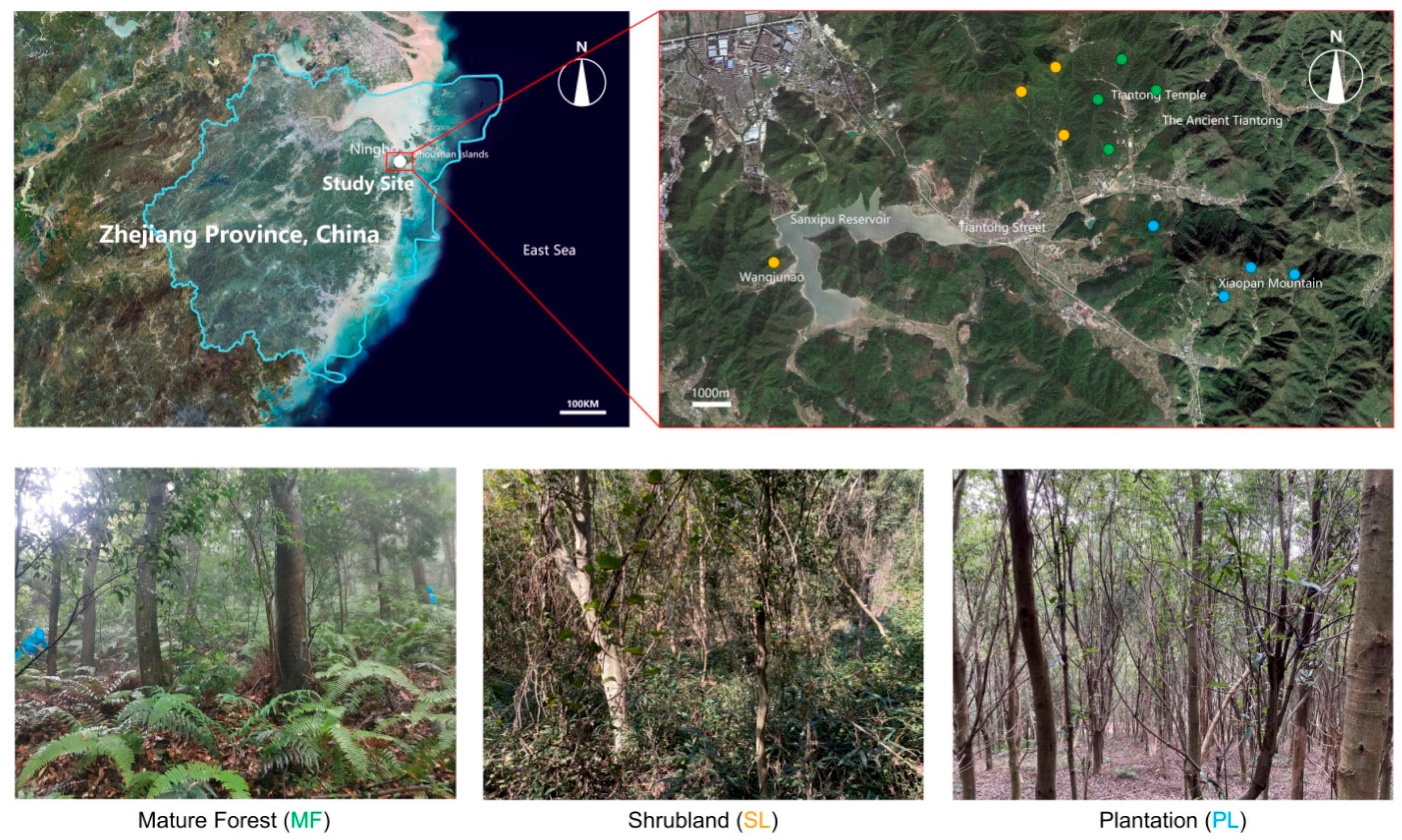
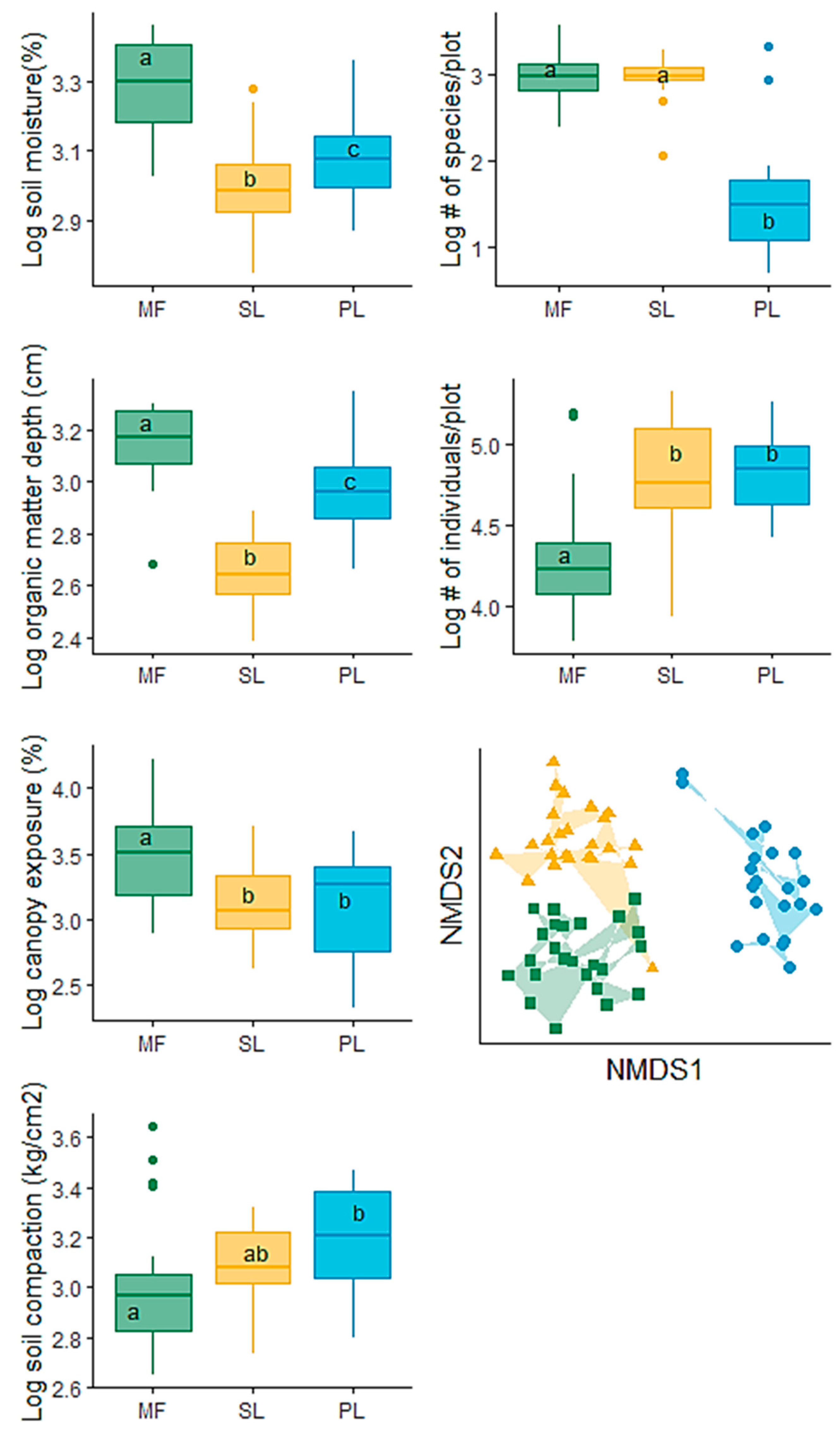
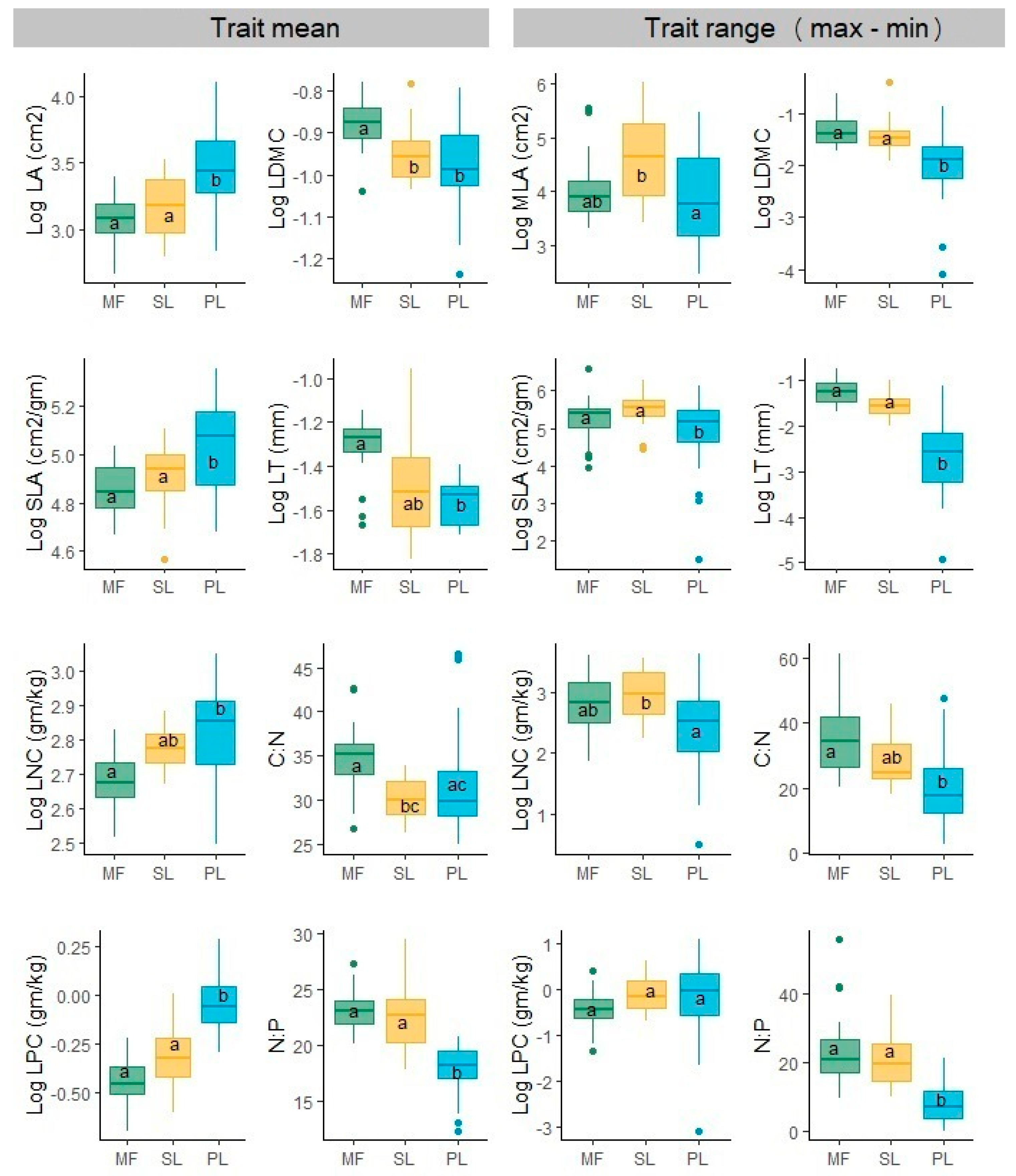
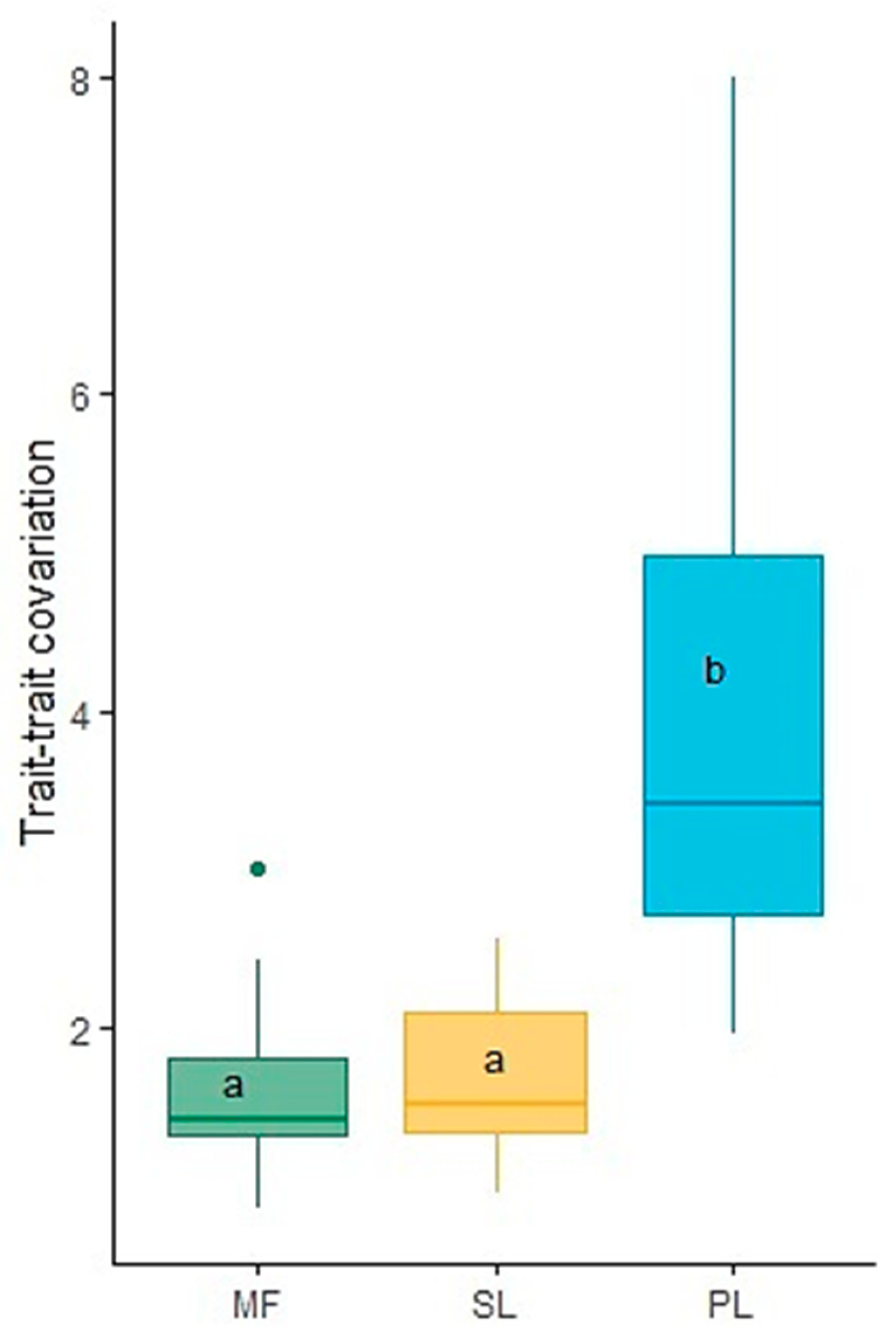
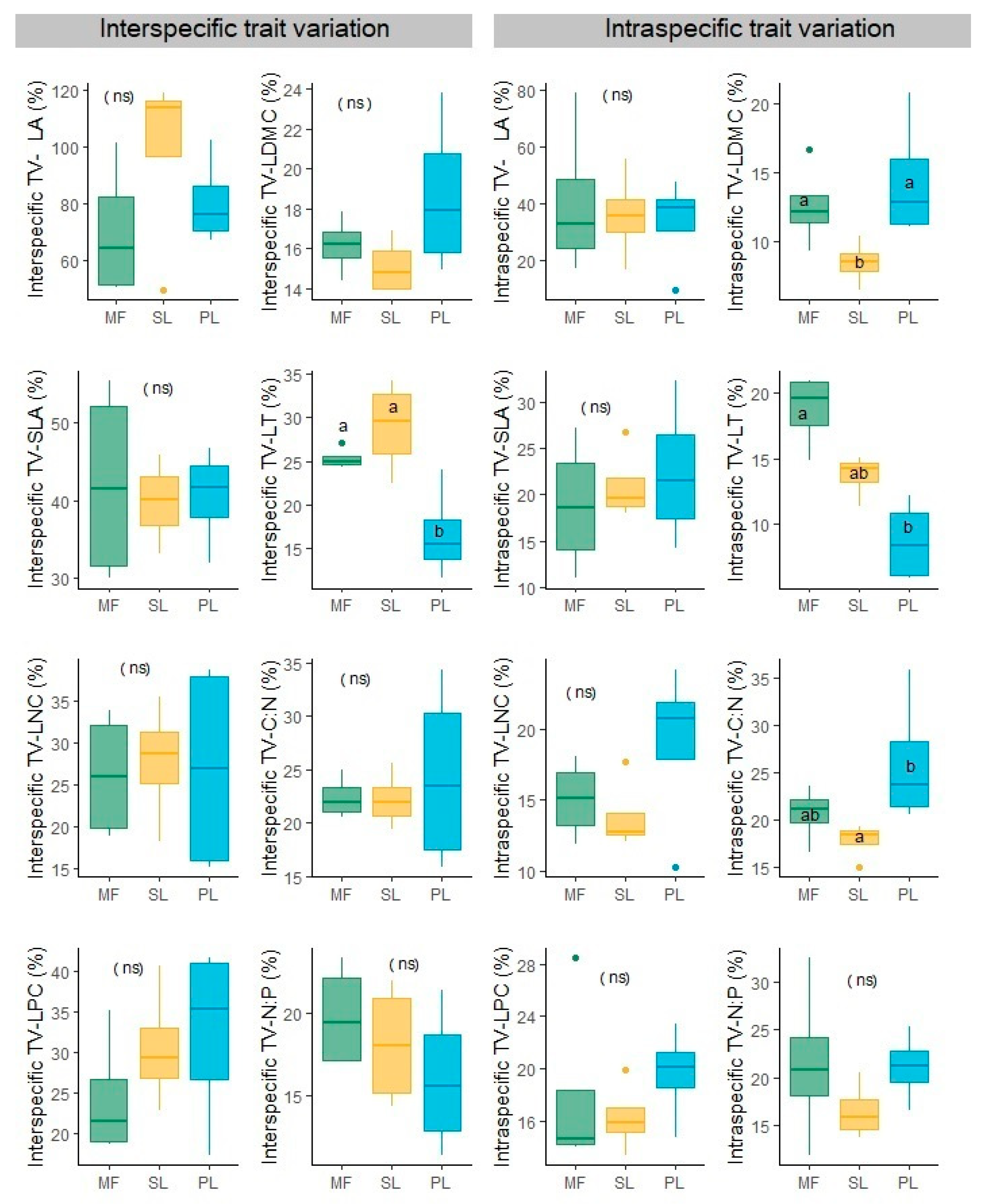
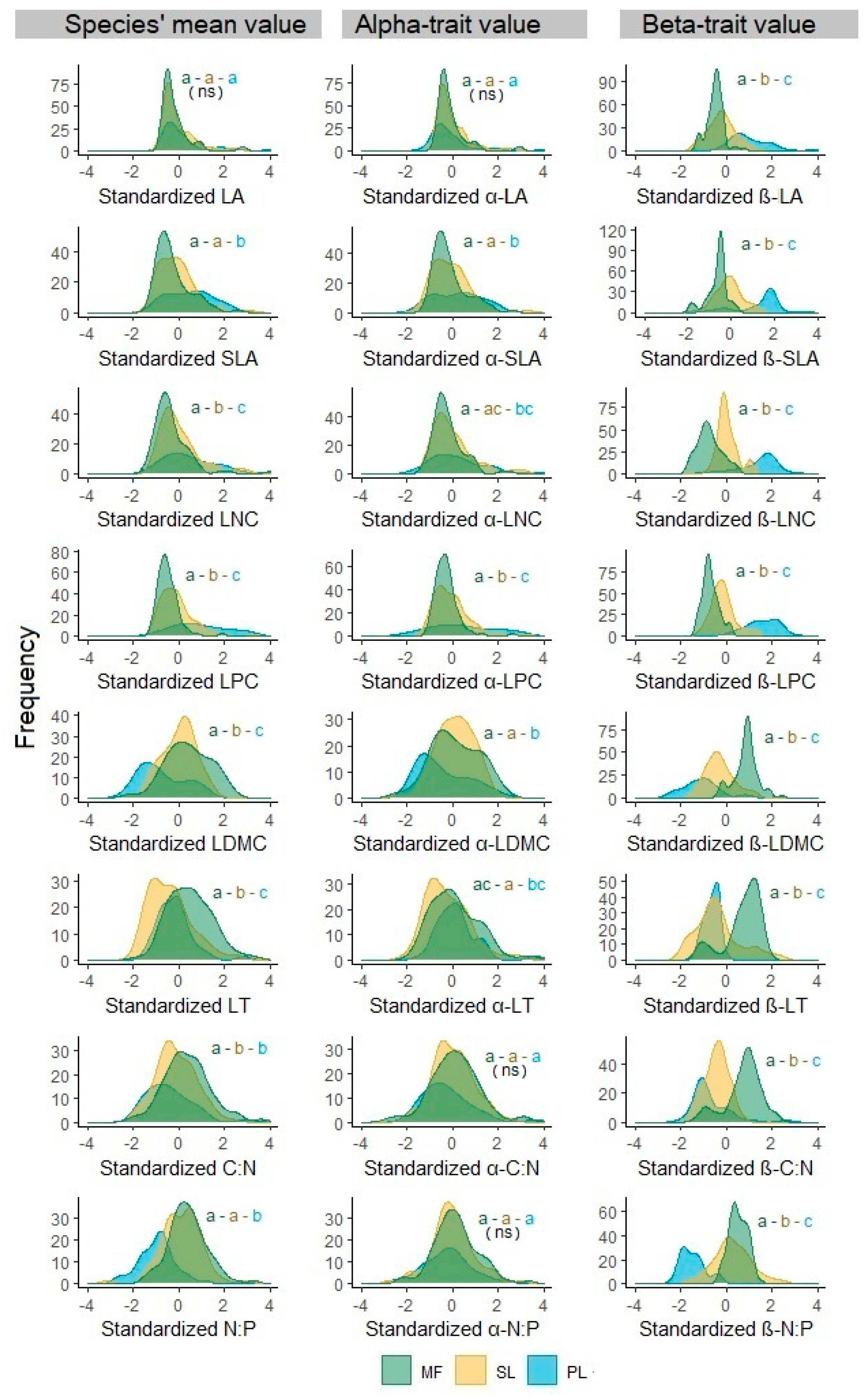

| Traits | Interspecific Trait Variation (%) | Intraspecific Trait Variation (%) |
|---|---|---|
| LA | 68.3 | 31.7 |
| SLA | 68.3 | 31.7 |
| LDMC | 60.5 | 39.5 |
| LT | 61.6 | 38.4 |
| LNC | 69.6 | 30.4 |
| LPC | 62 | 38 |
| C:N | 47.5 | 52.5 |
| N:P | 34.2 | 65.8 |
Publisher’s Note: MDPI stays neutral with regard to jurisdictional claims in published maps and institutional affiliations. |
© 2022 by the authors. Licensee MDPI, Basel, Switzerland. This article is an open access article distributed under the terms and conditions of the Creative Commons Attribution (CC BY) license (https://creativecommons.org/licenses/by/4.0/).
Share and Cite
Ouyang, J.; Biswas, S.R.; Yin, C.; Qing, Y.; Biswas, P.L. Shifting Importance of Abiotic versus Biotic Filtering from Intact Mature Forests to Post-Clearcut Secondary Forests. Forests 2022, 13, 672. https://doi.org/10.3390/f13050672
Ouyang J, Biswas SR, Yin C, Qing Y, Biswas PL. Shifting Importance of Abiotic versus Biotic Filtering from Intact Mature Forests to Post-Clearcut Secondary Forests. Forests. 2022; 13(5):672. https://doi.org/10.3390/f13050672
Chicago/Turabian StyleOuyang, Junkang, Shekhar R. Biswas, Chaoqin Yin, Yanxia Qing, and Prity L. Biswas. 2022. "Shifting Importance of Abiotic versus Biotic Filtering from Intact Mature Forests to Post-Clearcut Secondary Forests" Forests 13, no. 5: 672. https://doi.org/10.3390/f13050672
APA StyleOuyang, J., Biswas, S. R., Yin, C., Qing, Y., & Biswas, P. L. (2022). Shifting Importance of Abiotic versus Biotic Filtering from Intact Mature Forests to Post-Clearcut Secondary Forests. Forests, 13(5), 672. https://doi.org/10.3390/f13050672






